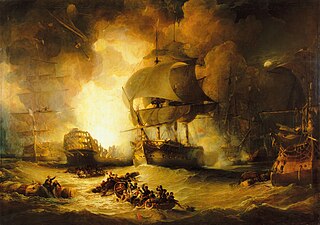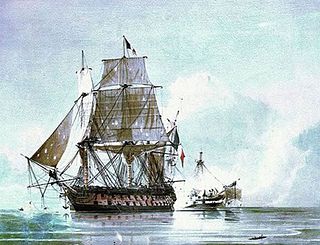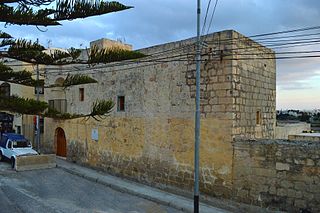 W
WThe Mediterranean campaign of 1798 was a series of major naval operations surrounding a French expeditionary force sent to Egypt under Napoleon Bonaparte during the French Revolutionary Wars. The French Republic sought to capture Egypt as the first stage in an effort to threaten British India and support Tipu Sultan, and thus force Great Britain to make peace. Departing Toulon in May 1798 with over 40,000 troops and hundreds of ships, Bonaparte's fleet sailed southeastwards across the Mediterranean Sea. They were followed by a small British squadron under Rear-Admiral Sir Horatio Nelson, later reinforced to 13 ships of the line, whose pursuit was hampered by a lack of scouting frigates and reliable information. Bonaparte's first target was the island of Malta, which was under the government of the Knights of St. John and theoretically granted its owner control of the Central Mediterranean. Bonaparte's forces landed on the island and rapidly overwhelmed the defenders, securing the port city of Valletta before continuing to Egypt. When Nelson learned of the French capture of the island, he guessed the French target to be Egypt and sailed for Alexandria, but passed the French during the night of 22 June without discovering them and arrived off Egypt first.
 W
WThe Action of 15 July 1798 was a minor naval battle of the French Revolutionary Wars, fought off the Spanish Mediterranean coast by the Royal Navy ship of the line HMS Lion under Captain Manley Dixon and a squadron of four Spanish Navy frigates under Commodore Don Felix O'Neil. Lion was one of several ships sent into the Western Mediterranean by Vice-Admiral Earl St Vincent, commander of the British Mediterranean Fleet based at the Tagus in Portugal during the late spring of 1798. The Spanish squadron was a raiding force that had sailed from Cartagena in Murcia seven days earlier, and was intercepted while returning to its base after an unsuccessful cruise. Although together the Spanish vessels outweighed the British ship, individually they were weaker and Commodore O'Neil failed to ensure that his manoeuvrees were co-ordinated. As a result, one of the frigates, Santa Dorotea, fell out of the line of battle and was attacked by Lion.
 W
WThe Action of 18 August 1798 was a minor naval engagement of the French Revolutionary Wars, fought between the British fourth rate ship HMS Leander and the French ship of the line Généreux. Both ships had been engaged at the Battle of the Nile three weeks earlier, in which a British fleet under Rear-Admiral Sir Horatio Nelson had destroyed a French fleet at Aboukir Bay on the Mediterranean coast of Egypt. Généreux was one of only four French ships to survive the battle, while Leander had been detached from the British fleet by Nelson on 6 August. On board, Captain Edward Berry sailed as a passenger, charged with carrying despatches to the squadron under Earl St Vincent off Cadiz. On 18 August, while passing the western shore of Crete, Leander was intercepted and attacked by Généreux, which had separated from the rest of the French survivors the day before.
 W
WThe Action of 27 June 1798 was a minor naval engagement between British and French frigates in the Strait of Sicily in the Mediterranean Sea. The engagement formed part of a wider campaign, in which a major French convoy sailed from Toulon to Alexandria at the start of the Napoleonic campaign in Egypt. The French frigate Sensible had been detached from the convoy after the capture of Malta, under orders to carry wounded soldiers and looted treasure back to France while the main body continued to Egypt. The British frigate HMS Seahorse was one of a number of vessels detached from the main British Mediterranean Fleet in the Tagus River, sent to augment the fleet under Sir Horatio Nelson that was actively hunting the French convoy.
 W
WThe Battle of the Nile was a major naval battle fought between the British Royal Navy and the Navy of the French Republic at Aboukir Bay on the Mediterranean coast off the Nile Delta of Egypt from the 1st to the 3rd of August 1798. The battle was the climax of a naval campaign that had raged across the Mediterranean during the previous three months, as a large French convoy sailed from Toulon to Alexandria carrying an expeditionary force under General Napoleon Bonaparte. The British fleet was led in the battle by Rear-Admiral Sir Horatio Nelson; they decisively defeated the French under Vice-Admiral François-Paul Brueys d'Aigalliers.
 W
WThe Siege of Corfu was a military operation by a joint Russian and Turkish fleet against French troops occupying the island of Corfu.
 W
WThe French invasion of Malta was the successful invasion of the islands of Malta and Gozo, then ruled by the Order of St. John, by the French First Republic led by Napoleon in June 1798 as part of the Mediterranean campaign of the French Revolutionary Wars.
 W
WThe Siege of Malta, also known as the Siege of Valletta or the French Blockade, was a two-year siege and blockade of the French garrison in Valletta and the Three Cities, the largest settlements and main port on the Mediterranean island of Malta, between 1798 and 1800. Malta had been captured by a French expeditionary force during the Mediterranean campaign of 1798, and garrisoned with 3,000 men under the command of Claude-Henri Belgrand de Vaubois. After the British Royal Navy destroyed the French Mediterranean Fleet at the Battle of the Nile on 1 August 1798, the British were able to initiate a blockade of Malta, assisted by an uprising among the native Maltese population against French rule. After its retreat to Valletta, the French garrison faced severe food shortages, exacerbated by the effectiveness of the British blockade. Although small quantities of supplies arrived in early 1799, there was no further traffic until early 1800, by which time starvation and disease was having a disastrous effect on health, morale, and combat capability of the French troops.
 W
WIn November 1798 a British expedition captured the island of Menorca from Spain. A large force under General Charles Stuart landed on the island and forced its Spanish garrison to surrender in eight days with only some bloodshed. The British occupied the island for four years, using it as a major naval base, before handing it back to Spain following the Treaty of Amiens.
 W
WThe Battle of the Nile was a significant naval action fought during 1–3 August 1798. The battle took place in Aboukir Bay, near the mouth of the River Nile on the Mediterranean coast of Egypt and pitted a British fleet of the Royal Navy against a fleet of the French Navy. The battle was the climax of a three-month campaign in the Mediterranean during which a huge French convoy under General Napoleon Bonaparte had sailed from Toulon to Alexandria via Malta. Despite close pursuit by a British fleet of thirteen ships of the line, one fourth rate and a sloop under Sir Horatio Nelson, the French were able to reach Alexandria unscathed and successfully land an army, which Bonaparte led inland. The fleet that had escorted the convoy, consisting of thirteen ships of the line, four frigates and a number of smaller vessels under Vice-amiral François-Paul Brueys D'Aigalliers, anchored in Aboukir Bay as Alexandria harbour was too narrow, forming a line of battle that was protected by shoals to the north and west.